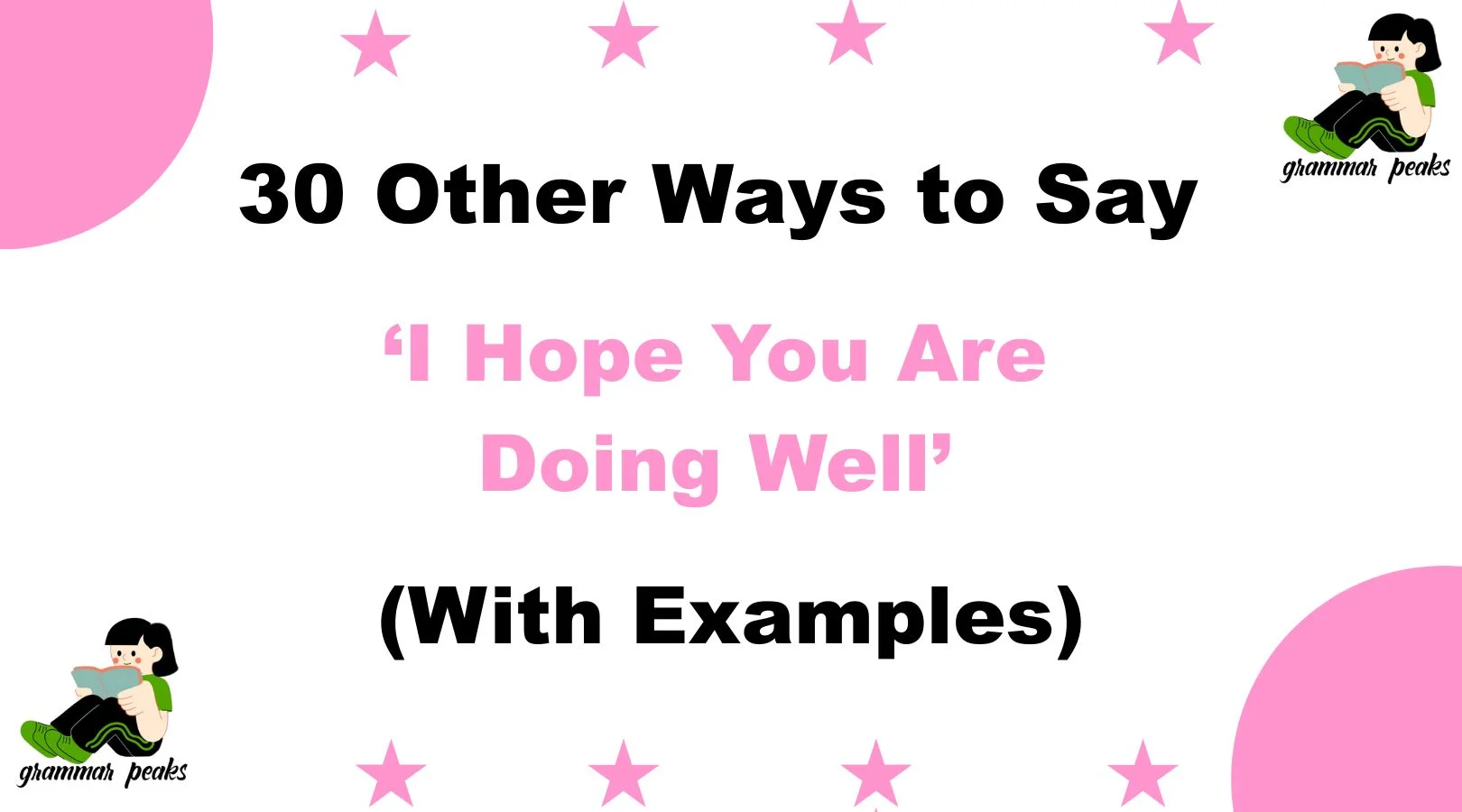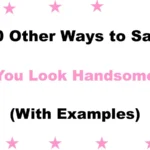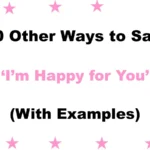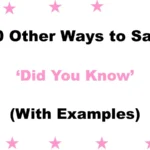In everyday communication—whether emails, texts, or letters—“I hope you are doing well” is a go-to phrase to show care and kindness. But when used too often, it can start to feel impersonal or routine. That’s why finding alternative ways to express the same warmth can make your message more thoughtful, genuine, and memorable.
Whether you’re checking in with a colleague, writing a friend, or starting a professional email, this guide gives you 30 unique and meaningful alternatives. Each phrase comes with definitions, examples, and best-use cases to help you choose the one that fits your tone, your intent, and your audience.
What Does “I Hope You Are Doing Well” Mean?
“I hope you are doing well” is a common and thoughtful greeting used to express genuine care for someone’s well-being. It conveys a simple but meaningful message—that you’re thinking about the person and hoping that their life, health, and emotional state are in a good place. Often used at the beginning of emails, messages, or letters, this phrase sets a kind and respectful tone for the conversation.
When to Use “I Hope You Are Doing Well”
Use this phrase when you want to:
- Start a conversation on a kind and considerate note
- Maintain professional etiquette in emails or messages
- Check in with someone you haven’t spoken to in a while
It works well in both personal and professional settings, but using more personal or specific alternatives can feel more sincere depending on the relationship.
Is It Professional/Polite to Say “I Hope You Are Doing Well”?
Absolutely. This phrase is professional, polite, and respectful. However, it may sound generic or overused if used too frequently or without context. Replacing it with more personalized or situation-specific language can strengthen your connection and engagement.
Pros and Cons of Saying “I Hope You Are Doing Well”
Pros:
- Friendly and non-intrusive way to begin a message
- Suitable in almost all contexts
- Adds warmth to professional emails
Cons:
- May seem impersonal or generic if overused
- Can be perceived as filler text without follow-up
- Less effective in emotional or deeply personal situations
Synonyms for “I Hope You Are Doing Well”
- I hope things are going great for you
- I trust this message finds you well
- I’ve been thinking of you
- Sending good vibes your way
- I hope life’s treating you kindly
- Hoping everything’s going smoothly
- Trusting all is well with you
- Just checking in on you
- I hope you’re staying healthy and safe
- I hope your week’s off to a good start
- Wishing you peace and calm today
- I hope you’re in good spirits
- Thinking warm thoughts for you
- I hope your days are full of light
- I hope things are falling into place
- Hope all is calm and bright on your end
- I trust things are settling down for you
- I hope you’re finding balance
- I hope today is being kind to you
- Hope your heart is light today
- I hope your work-life is manageable
- Sending you strength and peace
- I trust you’re navigating things well
- I hope joy has found you lately
- Just wanted to send some care your way
- May your day be gentle and kind
- I hope your plans are coming together
- I hope your space is calm and cozy
- Wishing you grounding and clarity
- I hope you’re surrounded by kindness
1. I Hope Things Are Going Great for You
Definition: A slightly more enthusiastic version of the original.
Detailed Explanation: Adds an upbeat tone and suggests things are not just okay—but great.
Scenario Example: Beginning an email to a coworker before discussing a project.
Best Use: Semi-formal to informal communication.
Worst Use: Very serious or somber contexts.
Tone: Upbeat and optimistic.
2. I Trust This Message Finds You Well
Definition: A polished and professional variation.
Detailed Explanation: Common in formal writing; sounds sincere and respectful.
Scenario Example: Business email or client follow-up.
Best Use: Professional or formal emails.
Worst Use: Casual or emotional conversations.
Tone: Respectful and polished.
3. I’ve Been Thinking of You
Definition: A heartfelt, emotionally aware check-in.
Detailed Explanation: Best used when you want to show personal concern or emotional presence.
Scenario Example: Message to a friend who’s been quiet lately.
Best Use: Close friends, family, or someone going through something.
Worst Use: Professional or unfamiliar relationships.
Tone: Warm and empathetic.
4. Sending Good Vibes Your Way
Definition: A casual and encouraging sentiment.
Detailed Explanation: Perfect for a light tone and showing positive intent.
Scenario Example: Commenting on a friend’s social post or text.
Best Use: Informal settings, texts, social messages.
Worst Use: Professional communications.
Tone: Playful and positive.
5. I Hope Life’s Treating You Kindly
Definition: A poetic and thoughtful alternative.
Detailed Explanation: Suggests care for the person’s life overall.
Scenario Example: Reconnecting with an old friend.
Best Use: Friendly or slightly poetic tones.
Worst Use: Business settings.
Tone: Reflective and kind.
6. Hoping Everything’s Going Smoothly
Definition: A calm, balanced way to show care for how life is unfolding for someone.
Detailed Explanation: This version focuses more on peace and steadiness rather than just general wellness.
Scenario Example: Emailing a client during a busy project cycle.
Best Use: Professional and semi-formal messages.
Worst Use: When someone is clearly going through turmoil or hardship.
Tone: Neutral, caring, and composed.
7. Trusting All Is Well with You
Definition: A formal yet warm greeting rooted in trust and care.
Detailed Explanation: Often used in professional emails, this phrase subtly implies positive expectations.
Scenario Example: Reaching out to a business contact or professor.
Best Use: Formal or business communication.
Worst Use: Casual text messages.
Tone: Professional and respectful.
8. Just Checking in on You
Definition: A friendly and direct message that shows genuine interest.
Detailed Explanation: Great for reaching out to people you haven’t heard from in a while.
Scenario Example: Texting a friend you haven’t seen in months.
Best Use: Casual or semi-formal settings.
Worst Use: Business introductions or first-time messages.
Tone: Friendly and sincere.
9. I Hope You’re Staying Healthy and Safe
Definition: A caring and socially aware variation.
Detailed Explanation: Especially relevant during times of health concerns or crises.
Scenario Example: Messaging colleagues during flu season or travel.
Best Use: Public health concerns, uncertain times, or distant contacts.
Worst Use: When the context doesn’t require health-related concern.
Tone: Considerate and conscious.
10. I Hope Your Week’s Off to a Good Start
Definition: A time-specific way to wish someone well.
Detailed Explanation: Adds a current context that makes your message feel fresh and present.
Scenario Example: Sending a Monday morning email.
Best Use: Early-week communication.
Worst Use: Sent later in the week—it may sound disconnected.
Tone: Timely and upbeat.
11. Wishing You Peace and Calm Today
Definition: A soft, mindful expression that prioritizes well-being.
Detailed Explanation: Ideal for people who are stressed or going through a lot.
Scenario Example: A message to a friend under pressure.
Best Use: Emotional support situations.
Worst Use: Formal emails or client outreach.
Tone: Gentle and compassionate.
12. I Hope You’re in Good Spirits
Definition: A cheerier way to wish for emotional positivity.
Detailed Explanation: Goes beyond physical well-being and focuses on emotional tone.
Scenario Example: Texting a friend during exam season.
Best Use: Friends, family, or coworkers with whom you have rapport.
Worst Use: In messages requiring seriousness.
Tone: Uplifting and caring.
13. Thinking Warm Thoughts for You
Definition: An affectionate and nurturing greeting.
Detailed Explanation: Best for people going through something heavy or uncertain.
Scenario Example: A message to someone grieving or facing a challenge.
Best Use: Close friends and family.
Worst Use: Business or networking emails.
Tone: Comforting and emotional.
14. I Hope Your Days Are Full of Light
Definition: A poetic, imagery-rich version of well-wishing.
Detailed Explanation: Ideal for creative or spiritually-inclined recipients.
Scenario Example: Writing on a birthday or encouragement card.
Best Use: Artistic or expressive relationships.
Worst Use: Professional or direct communication.
Tone: Poetic and heartfelt.
15. I Hope Things Are Falling into Place
Definition: Shows support for someone trying to manage or transition through challenges.
Detailed Explanation: Suggests belief that their life will become more organized or peaceful.
Scenario Example: Message to a friend moving to a new city.
Best Use: Supportive or transitional moments.
Worst Use: When you’re unaware of someone’s situation—it could feel presumptive.
Tone: Encouraging and hopeful.
16. Hope All Is Calm and Bright on Your End
Definition: A peaceful and festive phrase with a warm tone.
Detailed Explanation: Combines calmness and light in one wish—great for the holiday season.
Scenario Example: A December message to coworkers or friends.
Best Use: Holiday season greetings or end-of-year emails.
Worst Use: Mid-year, unless tone fits.
Tone: Festive and kind.
17. I Trust Things Are Settling Down for You
Definition: A supportive and acknowledging phrase.
Detailed Explanation: Great for someone recovering from a stressful time.
Scenario Example: Following up with a friend after exams or a move.
Best Use: Transitional periods.
Worst Use: To someone currently experiencing chaos—it may feel dismissive.
Tone: Reassuring and calm.
18. I Hope You’re Finding Balance
Definition: A thoughtful phrase recognizing the importance of well-being.
Detailed Explanation: Perfect for people juggling multiple responsibilities.
Scenario Example: To a working parent or college student.
Best Use: Messages where mental/emotional well-being is relevant.
Worst Use: Cold professional settings.
Tone: Mindful and caring.
19. I Hope Today Is Being Kind to You
Definition: A present-focused and emotionally intelligent phrase.
Detailed Explanation: Encourages a gentle check-in on the current moment.
Scenario Example: Morning texts or midday emails.
Best Use: Daily check-ins or thoughtful notes.
Worst Use: Formal correspondence.
Tone: Soft and supportive.
20. Hope Your Heart Is Light Today
Definition: A heartfelt way to acknowledge someone’s emotional state.
Detailed Explanation: Goes deeper than surface-level greetings.
Scenario Example: After a tough conversation or personal news.
Best Use: Close relationships.
Worst Use: General audience or professional space.
Tone: Emotional and intimate.
21. I Hope Your Work-Life Is Manageable
Definition: A practical, understanding phrase.
Detailed Explanation: Acknowledges the pressure of modern life and shows support.
Scenario Example: Messaging a colleague during a busy season.
Best Use: Coworkers or professional contacts.
Worst Use: Casual friends or non-working individuals.
Tone: Supportive and relatable.
22. Sending You Strength and Peace
Definition: Encouraging and comforting well-wishes.
Detailed Explanation: Ideal for someone facing a challenge or stress.
Scenario Example: After someone shares tough news.
Best Use: Emotional support.
Worst Use: Light or upbeat scenarios.
Tone: Strong and empathetic.
23. I Trust You’re Navigating Things Well
Definition: Acknowledging effort and offering affirmation.
Detailed Explanation: Perfect when someone is busy or going through a change.
Scenario Example: Friend starting a new job or parent adjusting to a new routine.
Best Use: Encouraging notes for people under pressure.
Worst Use: Unfamiliar audiences.
Tone: Affirming and respectful.
24. I Hope Joy Has Found You Lately
Definition: A whimsical and kind-hearted message.
Detailed Explanation: Communicates care and hope for positivity.
Scenario Example: Reaching out to a long-lost friend.
Best Use: Reconnection or emotional support.
Worst Use: Business settings.
Tone: Wholesome and hopeful.
25. Just Wanted to Send Some Care Your Way
Definition: Direct and warm.
Detailed Explanation: No frills—just an open-hearted check-in.
Scenario Example: A short message to a friend.
Best Use: Any personal relationship.
Worst Use: Cold or formal emails.
Tone: Friendly and honest.
26. May Your Day Be Gentle and Kind
Definition: A tender and poetic well-wish.
Detailed Explanation: Great for comforting someone or softening a tough day.
Scenario Example: Morning text or email to a loved one.
Best Use: Sensitive situations.
Worst Use: Corporate communication.
Tone: Tender and nurturing.
27. I Hope Your Plans Are Coming Together
Definition: Encouraging progress and positive momentum.
Detailed Explanation: Best used when someone is working toward a goal.
Scenario Example: During a big move, wedding, or project.
Best Use: Transitional moments.
Worst Use: Generic greetings.
Tone: Motivating and optimistic.
28. I Hope Your Space Is Calm and Cozy
Definition: A very personal and sensory-based wish.
Detailed Explanation: Focuses on one’s physical and emotional environment.
Scenario Example: Message to a friend working from home.
Best Use: Intimate and casual connections.
Worst Use: Business emails.
Tone: Warm and homey.
29. Wishing You Grounding and Clarity
Definition: A thoughtful phrase for mindfulness and peace.
Detailed Explanation: Great for someone feeling overwhelmed.
Scenario Example: Friend facing a tough decision.
Best Use: Deep or emotional conversations.
Worst Use: Superficial chats.
Tone: Centered and calming.
30. I Hope You’re Surrounded by Kindness
Definition: A beautiful and compassionate greeting.
Detailed Explanation: Highlights social support and emotional well-being.
Scenario Example: Card for someone going through a hard time.
Best Use: Sensitive or caring situations.
Worst Use: Corporate emails.
Tone: Loving and generous.
Conclusion
Finding meaningful alternatives to “I hope you are doing well” isn’t just about variety—it’s about showing up in your communication with intention, warmth, and presence. Whether you’re writing a professional email, checking in with a friend, or supporting someone through a tough time, the words you choose can offer real comfort and connection. Use this list of 30 heartfelt alternatives to craft messages that resonate, stand out, and feel truly human.
FAQs
1. Why should I avoid saying “I hope you are doing well” too often?
While “I hope you are doing well” is polite and kind, it’s used so frequently that it can sometimes feel generic or impersonal. Using more tailored alternatives helps your message feel more thoughtful, sincere, and engaging, especially when writing to someone you care about or when you want to stand out professionally.
2. Are these alternatives appropriate for professional emails?
Yes—many of the listed phrases (like “I trust this message finds you well” or “Hoping everything’s going smoothly”) are professional, polite, and respectful. The key is to match the tone of the message to your audience—use formal versions in the workplace and more casual ones with friends or family.
3. What’s the best alternative for emotional or difficult situations?
In emotional or sensitive contexts, opt for phrases like “Sending you strength and peace,” “Thinking warm thoughts for you,” or “May your day be gentle and kind.” These show compassion and support while avoiding empty formalities.
4. Can I use these greetings to start an email or text message?
Absolutely. These alternatives are designed to help you begin any message warmly and personally, whether it’s a quick check-in, a formal email, or a longer personal note. Starting with care sets a positive tone for the rest of your message.
5. How do I choose the best alternative for each situation?
Think about the tone, your relationship with the recipient, and the context. For professional settings, use polished alternatives. For close friends or family, choose heartfelt and comforting ones. For tough moments, pick gentle, supportive phrases that offer emotional grounding.






